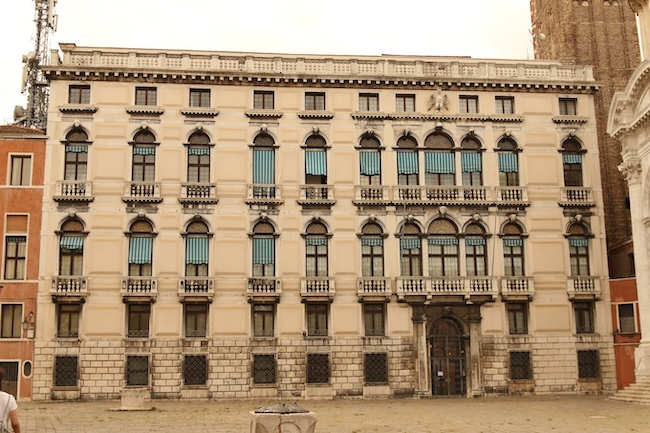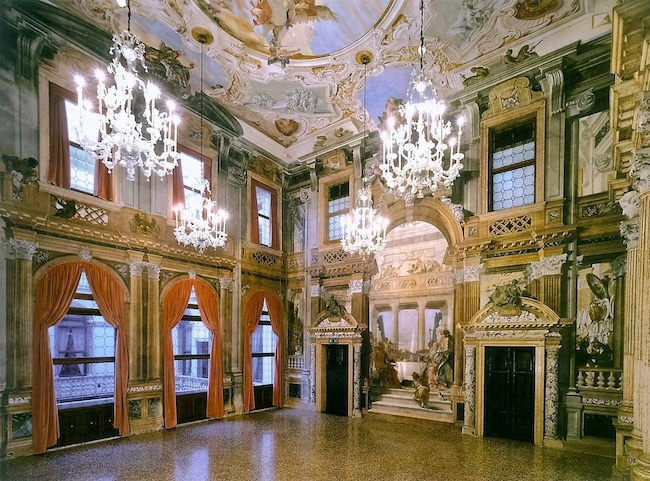Palazzo Labia is a Baroque jewel standing majestically at the junction of the Grand Canal and the Cannaregio Canal in Venice. It is a remarkable work of architecture dating from the 17th century. Built for the Labia family, originally from Catalonia and integrated into the Venetian nobility, the palace illustrates the wealth and social status the family had acquired through their prolific commercial activities.
Celebrated for its lush interior, it features a ballroom decorated with frescoes by Giovanni Battista Tiepolo, reflecting the major artistic and cultural aspects of the period.

From the outside, Palazzo Labia impresses with its monumental facades, the work of Andrea Cominelli and Alessandro Tremignon, which give the building an imposing presence within the Venetian urban landscape. The palace remains one of Venice's last great palacesIt marked the apogee of Venetian palatial architecture before the decline of the Republic.
The interior, accessible on selected tours, continues to captivate visitors with its works of art and fascinating history.
Keys to remember
- Palazzo Labia in Venice is famous for its rich history and imposing Baroque architecture.
- The palace is particularly noteworthy for the fresco by Tiepolo in its ballroom.
- A must for travelers seeking to discover Venetian cultural and artistic heritage.
History and Architecture
Discovered by our team of local experts, the origins of Palazzo Labia date back to the golden age of the Venetian Republic. This Baroque palace bears witness to the influence and aesthetics of the Venetian nobility.
Labia et Construction family
The construction of Palazzo Labia was initiated by the wealthy Labia family, originally from Catalonia and now based in Venice, who sought to assert their status among the nobility. Their efforts crystallized in the mid-17th century, when this grand palace began to take shape on the banks of the Grand Canal and the Cannaregio Canal, in Venice. the Cannaregio district.
Design by Giorgio Massari and Alessandro Tremignon
The palace was designed by prolific Baroque architects, including Giorgio Massari who contributed to the overall design. Alessandro Tremignon was responsible for the facade overlooking Campo San GeremiaThe result is a harmony between Baroque codes and the elegance of classic Venetian palazzi.
The result is an architectural masterpiece that respects the aesthetics of the period, yet is also in keeping with the more classical Venetian palazzo, marking a progression from traditional Venetian Gothic.

Art and Culture
The following article draws its information from the team of local experts at Bonjour Venise, your daily reference for a memorable trip.
Tiepolo's frescoes
The Palazzo Labia shines with its frescoes created by Giambattista Tiepolo and Gerolamo Mengozzi-Colonna. The centerpiece is the Salone delle Festewhere Tiepolo immortalized the dramatic plot between Anthony and Cleopatra.
Legend has it that he even painted his self-portrait there, blending in with the illustrious scenes he depicted. This fresco cycle represents one of the most eloquent examples of 18th-century Venetian art, accessible to the general public. public viewing.
Celebrations and milestones
The Palazzo Labia has seen countless milestones since its construction. In 1951, the famous Cecil Beaton photographs a masked ball organized by Carlos de Beisteguiwhich is remembered as one of Venice's most lavish celebrations.
A legacy of its opulent past, the palace today serves as a venue for a variety of cultural events. Over the years, it has alternated between puppet theater, Inquisition headquarters and ballroom, without ever losing its aura of grandeur.
Frequently asked questions
In this article, our team of local experts provides up-to-date information on Palazzo Labia, a jewel of Venetian Baroque architecture.
What are the opening hours of Palazzo Labia in Venice?
Palazzo Labia is open to the public for visits at specific times, which may vary. We recommend consulting the official website or contacting the palace directly for the latest information on opening times.
What famous works of art can be seen at Palazzo Labia?
Giambattista Tiepolo's frescoes in the Palazzo's sumptuous ballroom are a must-see. They depict mythological and allegorical scenes and are considered among the most significant of the Baroque period.
Can you organize private events at Palazzo Labia?
Yes, Palazzo Labia offers space for private events such as weddings and receptions. It is advisable to contact the palace administration directly to discuss possibilities and conditions.
How do I get to Palazzo Labia by public transport?
Palazzo Labia can be reached by public transport in Venice. Visitors can take vaporettos that stop nearby. Precise lines and routes can be consulted on the Venice transport website or via dedicated apps.
Is there an entrance fee to visit Palazzo Labia?
Entrance to Palazzo Labia generally requires an entrance fee, but this may vary according to temporary exhibitions or special events. Details and updated rates are available on the official website or can be obtained by contacting the palace.
What is the history of Palazzo Labia and the family that gave it its name?
Palazzo Labia was built in the 17th century for the wealthy Catalan Labia family. They joined the Venetian nobility in 1646. One of the last great palazzi in Venice, it illustrates the pomp and wealth of its original patrons.
What to do in Venice in 1 day, 2 days, 3 days, 5 days, a week?
Whatever the length of your stay, I invite you to download my special Venice guide.
It's free and in PDF format.
All you have to do is tell me below which e-mail address you'd like to receive it at.
EDIT: you can't enter your email?
Take the quiz at the top of this article and you'll be able to register your email address to receive the special Venice guide!
Leave a Reply